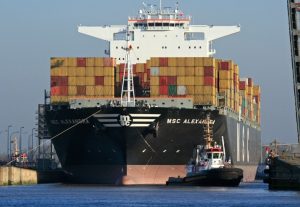We hear about it all the time: the great global supply chain crisis of 2021, a sheer inability to get goods out of the ports and eventually into the hands of consumers. There are plenty of fingers being pointed in all directions, including at our truckers’ inability to pick up and deliver the goods.
Various people have claimed that the trucking industry is plagued by high turnover, inadequate pay, and long hours. Yet, the existing evidence simply does not support this as the primary cause of the supply chain crisis. A 2019 report from the Bureau of Labor Statistics (BLS) found “relatively high rates of occupational attachment among drivers . . .that truck drivers respond in the expected manner to differences in earnings across occupations.”
BLS also found that “no reason to think that, given sufficient time, driver supply should fail to respond to price signals in the standard way.” And while there is a shortage of truckers, increased pay and truckers willing to work extra hours to supplement their income are helping to offset that dynamic. As Carlos Rameriz, a 25-year truck driving veteran, stated, “There’s a lot of us that are willing to work,” adding, “I don’t know anybody that is working 24/7.”
In other words, despite the issue of drivers, overall the trucking system is working just as it should, so there must other issues at play. Of course, the American consumer is largely culpable for the logjam. Walmart alone reported “a 45% increase in online sales over the 12 months to August,” according to cnn.com. And not surprisingly, Amazon’s “net sales have increased 44 percent to $108.5 billion in the first quarter of 2021,” according to engadget.com.
And, as factcheck.org points out, “cargo traffic has been rising since the pandemic took hold, as homebound Americans began ordering goods online, with a record number of ships waiting to enter ports at Los Angeles and Long Beach. Marine terminals and trucking companies have been unable to keep up with the volume, resulting in bottlenecks at ports and rail yards from California to New York.” Put simply, the stay-at-home scenario induced by the pandemic caused people to order stuff, a lot of stuff, flooding our ports and overwhelming out supply chains.
Still, we have a flexible economy and should have already adjusted, as the BLS report suggested, so there must be another factor. There is, and the source is the port itself as well as the web of highly interconnected elements that support the port.
Part othe problem relates to longshoremen, or more specifically, the unions that set working hours.
A recent article by Santura Pegram, a freelance writer and member of the AFL-CIO / International Longshoremen’s Association, states it plainly: “What most people outside of the maritime industry are unaware of is that it has often been influential shipping companies, bureaucracy, and questionable labor agreements made by weak-spirited union leaders who have continued to pick away at reducing the number of dockworkers (longshoremen and truckers) at job sites that has played the biggest role in causing unnecessary delays and congestion at U.S. seaports.”
This stance jives not only with Ramirez’s claims, but longshoremen themselves. Wishing to keep his identity hidden, a longshoreman named Alfred said that Pacific Maritime Association (PMA) one of several unions that represent workers in the shipping industry, are “the ones who are not training: skilled positions. [That] means crane operators, top handler drivers, trans drivers. They’re the ones who are keeping the ships out there at sea anchored.”
One of the largest unions representing longshoremen is the International Longshore and Warehouse Union (ILWU). The ILWU has had its share of issues. As Bloomberg reports, “In 2019, a jury ordered the union to pay $94 million to a terminal operator in Portland, Ore., for engaging in illegal work slowdowns, threatening to bankrupt the ILWU.”
Yet, others believe it is the shipping companies at fault; more precisely, the terminal operators, who are “responsible for assisting daily operations within the transportation or manufacturing agencies” according to zippia.com, an organization dedicated to providing information about career paths.
The broad importance of the role of the terminal operators, who work under the Terminal Operations Management Department, cannot be overstated. According to Syarifuddin Shukri, who studies supply chain management issues, a terminal operator “plans and manages all activities that will maintain sustainability by resolving any potential malfunction in terminal services.”
This is an argument advanced by Duane Martinez, vice president of ILWU Local 94 in Los Angeles, who contends that despite the demand for more work hours from longshoremen to address the backlog, this “hasn’t really kicked in if you ask me.” Instead, Martinez argues that the hold-up is terminal operators that aren’t giving additional work orders.
What all of this information reveals is that there is likely no one casual agent. Instated, there are multiple causes that contribute to the bottleneck of goods at ports, and some of them have nothing to do with the ports themselves, but are highly connected, nonetheless. This is precisely the conclusion of maritime economist John Martin, Ph.D, a consultant who specializes in assessing the economic costs of terminal congestion at container terminals.
Martin’s research indicates that the massive influx of goods into our ports has caused a domino type of effect. Specifically, Martin’s analysis has “found that much of the congestion originates far from the docks,” because “Warehouses are filled, causing back-ups all the way to port terminals, made worse by shortages of shipping containers, rail cars, trucks, and chassis to meet the enormous demand. These dynamics have driven delays, shortages, and increased prices at retailers nationwide.”
Let’s take a moment to unpack that information.
Port Factor # 1: Warehouses Are Full
Warehouses are the second major link in the supply chain after cargo is shipped from ports. They are the intermediary between the shipping company and the consumer. When these warehouses reach capacity, which is a byproduct of consumer demand, there is no place for new cargo to go, so goods begin to pile up at the ports. For example, NBC of Los Angeles reports that “Warehouses in Southern California are full, so shipping containers are piling up in nearby neighborhoods.” This dynamic is going on in ports acrss the United States.
So, even when truckers can procure a load from the ports, they have no place to take them, forcing them to often park their rigs in nearby neighborhoods. This compounds the problem of procuring new loads, because truckers must first clear their cargo before picking up a new load, thus adding to the backlog.

Source: joc.com
Port Factor # 2: Shortages of Shipping Containers
Ports are also facing a significant shortage of shipping containers, a crucial component of the supply chain. The USA Customs Clearance, a Licensed U.S. Customs Broker that provides a full range of customs clearance services, writes that “Shipping containers are the backbone of global trade. These large corrugated vessels are essential in transport overseas, via rail, and even down highways. However, like many kinds of essential equipment in 2021, shipping containers are currently in very scarce supply.”
This shortage is so pervasive that the publication Quartz reports “Indian exporters to North America and Europe are complaining that the wait times to find a shipping container can stretch as long as three weeks” and “British exporters say the shortage has delayed shipments to east Asia for up to two months.”
In essence, due to the increased worldwide demand for various products, empty containers pile up in several locations and are therefore unavailbe to ship goods elsewhere. As Harvard Business School professor Willy Shih, puts it, “What you see is a messy buildup of containers in places where they’re not supposed to be.”
This can be traced back in part to restrictions that were put in place at the beginning of the pandemic. As Quartz explains: “Cargo ships that were already en route out of Asia dropped off hundreds of thousands of containers full of goods in ports across the Americas—but because of pandemic restrictions, they couldn’t load those containers back up with new products to send back to Asia. Instead, the containers piled up in ports and inland rail depots.”

The end result was that “containers continued to pile up at major import centers” even as “their supply dwindled at major export hubs,” causing a mismatch between supply and demand. To make matters worse, it is extremely costly to ship back empty containers, so there is a disincentive to do so.
There is help on the horizon, however. The USA Customs Clearance points out that “Container production is at an all-time high, which means there will be many shipping containers available on the market soon” adding, “Some business experts predict the shortage will be resolved in 2022.”
However, we may end up creating another problem in our attempt to solve this one. Suresh Acharya, a professor at the University of Maryland’s business school who studies supply chains, argues “While there is certainly a need for more containers now…the post-pandemic steady-state will look more like the pre-pandemic times, so building more now may lead to a glut of containers later.”
Port Factor #3: A Lack of Shipping Chassis
A container chassis is a “specially designed trailer or wheeled carrier to transport containers from trucks between terminals, warehouses, and ports,” according to xChange Solutions, a company that specializes in shipping containers. Without a chassis, containers cannot be transported to their intended destination.
The Scarbrough Group, a global supply chain management group, states that multiple large-scale ports, such as Port of LA-Long Beach, Port of New York-New Jersey, Baltimore, Savannah, Chicago, Memphis, Dallas, Saint Louis, and Kansas City, have all been impacted by an ongoing shortage of chassis.
Much of this phenomenon has to do with the unprecedented increase in demand, as well as the connection to what I mentioned earlier, which is the fallow nature of shipping containers, because these containers are attached to chassis, making them unavailable as well.

But there are policy implications as well. The Scarbrough Group attributes part of the backup to the ELD (electronic logging devices) mandate. In essence, the ELD mandate requires the use of electronic devices to record data related to the operation of the vehicle and to driver activity.
Teletrac Navman US Ltd describes that “The driver information mainly concerns hours of service, or HOS” and functions as a “permanent record of driving hours, on-duty hours (when drivers are working but not driving) and rest time, over the course of a trip.” The ELD mandate was created to protect truckers from working such extended hours that it imperils their health and safety, thereby preventing dangerous and deadly collisions. And though this law is designed as a safety precaution, it has had the unintended consequence of narrowing the availability of drivers.
As The Scarbrough Group frames it: “With the implementation of the ELD Mandate, drivers can no longer pick up an extra load like they were used to doing prior to the regulation, (or even half a load for that matter). Therefore, units will actually end up setting unused longer.” And of course, attached to these loads are chassis.
In this sense, a chassis shortage exacerbates the container shortage, and vice versa, all of which impedes the functioning of the overall supply chain.
Potential Solutions to Port Problems
All of these factors, which are highly interconnected and interdependent, are crimping availability, thus driving up the ultimate cost, which is passed on to the consumer. And even though we now know what the problems are, there is one bigger problem: the blame game. As is typical in American politics, there are plenty of accusations and grievances, but little cooperation that might actually solve the problem, as complicated as it is.
In an interview with Business Insider, a longshoreman seemed to hit the proverbial nail on the head: “The shipping companies blame us for not covering skilled-labor jobs, but they’re the ones that approve training for those types of jobs. Then we turn around and blame COVID-19 for the influx of online orders. Consumers see the ships backed up and say we’re not unloading fast enough. Truckers complain about the lack of chassis at the port, which limits the number of containers that can be carried out of the yard. It’s a total blame game.”
This sentiment parallels Martin’s recommendation that “stakeholders must work collaboratively across industries to identify solutions that span the entire global supply chain.” This is where the Biden administration can actually help. While Biden has proposed using the national guard to help clear out the port backlogs, that is too limited a view.
He must also find a way to bring together seemingly disparate parties to hammer out an agreement they all find palatable and workable. This means that no one stakeholder will get everything they want, but we all win out in the end because the approach was comprehensive, thoughtful, and fully transparent. That’s what true leadership looks like. You roll up your sleeves and get into the trenches, not sit back in your ivory tower dolling out mandates and catering to party lines, a condition certainly not exclusive to the Biden administration.
At Newsweed.com, we adhere to three simple principles: truth, balance, and relatability. Our articles, podcasts, and videos strive to present content in an accurate, fair, yet compelling and timely manner. We avoid pushing personal or ideological agendas because our only agenda is creating quality content for our audience, whom we are here to serve. That is why our motto is ”Rolling with the times, straining for the truth.”
Your opinion matters. Please share your thoughts in our survey so that Newsweed can better serve you.






